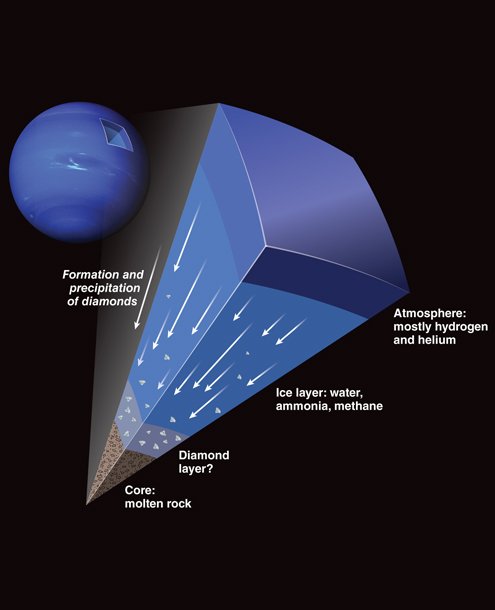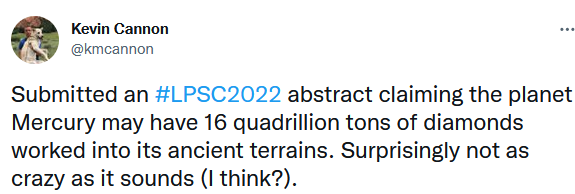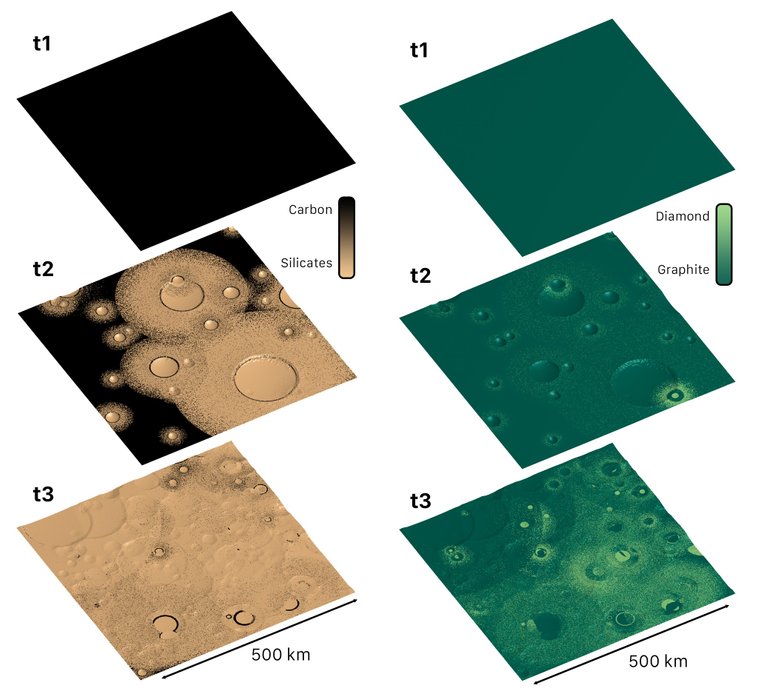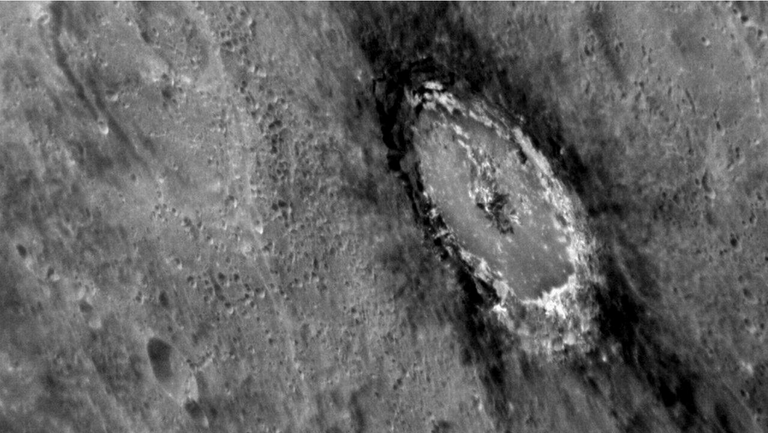It is not my crazy idea, it is Kevin Cannon's. Kevin is a Planetary Scientist working at the Colorado School of Mines where he teaches in Geology and the world's first Space Resources Program
His proposal is quite simple, Mercury's crust is made out of carbon in graphite form, the same material that pencil leads are made of. We know this composition based on the re-analysis of the Messenger probe data and it finally gave an explanation to why the planet is so dark in comparison with other similar bodies like the Moon.
Basically we can resume the theory in that if you have a a graphite crust over a sea of magma of around 100-300 meters thick during the times of the Heavy Bombardment (a violent time in our Solar System), parts of that graphite may have turned into diamonds due to the pressure of the impacts.
Carbon in exoplanets
Studying planets outside of our Solar System (Exoplanets) it has been found that they are cases where carbon is more common than oxygen, these are usually referred to as carbon rich planets. Recent studies show that carbon rich rocky planets may have a carbon based cycle with bicarbonate rain.
There is this possibility that exoplanets with a thicker graphite crusts than Mercury may have an outer layer of diamonds. And being diamond 50% denser than graphite it can affect interior dynamics. Late studies show that diamond structure of carbon can survive pressures bigger than Earth's core, information that is very interesting when we try to study gas planets
Raining diamonds in our Solar System
Yes, raining. It has been a largely theorized topic that Uranus and Neptune have diamond rains. New studies make us think that the diamond rain is also happening in Saturn and Jupiter.
Gas giant planets experiment huge pressures inside their bodies. The icy giants like Neptune an Uranus have ice layers inside their atmosphere, the models indicate that gravity can compress the ice in the middle layer to high densities and making temperature grow. In that situation ammonia and methane are reactive in exotic ways that include diamond formation. This is the most stable carbon form, and extremely dense, so they will precipitate. Depending on the conditions they may remain as solid rocks this or become liquid (For more: Ross, The ice layer in Uranus and Neptune—diamonds in the sky?).

Jason McAlexander - cutaway of Neptune
The study for Saturn shows the possibility that thunderstorms turn methane into soot, that when the pressure increases during the precipitation to lower layers of the atmosphere turns into graphite and potentially to diamonds. And again, there is the possibility of having an ocean of liquid carbon. (More)
Keep exploring
The more we explore, with probes or in the laboratory, more features we discover about how the planets on our Solar system and potentially in the rest of the Milky way behave. And we cannot continue learning without exploring. Moreover, discovering how the rest of the planets behave allows us to treat those environments as huge experimental fields to compare with the behaviour of our own planet and.
Coming back to the starting point of this article, we will still have to wait to read the whole model theorizing if Mercury can have a crust full of diamonds. It will be in the Lunar and Planetary Science Congress in March 2022.



Interesting fact. Soon, diamonds will be worth nothing :D
I especially enjoyed your conclusions about exploration, that is very true for all fields of science ^^
Absolutely. As you say, diamond is a material that is really worth nothing to harvest. So nobody really has a plan to go amd mine it.
Industrial production of diamonds for machinery like industrial cutters is quite extended and the product is getting cheaper and cheaper.
Diamonds for jewelery, that come from mined mineral, however keep an expensive price but who knows if that will continue as it is.
https://www.reuters.com/article/us-diamonds-debeers-synthetic-analysis-idUSKCN1OK0MQ
Oooh I didn't know about this lab-grown stuff. Interesting... although buying diamonds is a "no no" for me ;)
Congratulations @metabs! You have completed the following achievement on the Hive blockchain and have been rewarded with new badge(s):
Your next target is to reach 700 comments.
You can view your badges on your board and compare yourself to others in the Ranking
If you no longer want to receive notifications, reply to this comment with the word
STOPTo support your work, I also upvoted your post!
Check out the last post from @hivebuzz:
Support the HiveBuzz project. Vote for our proposal!
The rewards earned on this comment will go directly to the person sharing the post on Twitter as long as they are registered with @poshtoken. Sign up at https://hiveposh.com.
Thanks for your contribution to the STEMsocial community. Feel free to join us on discord to get to know the rest of us!
Please consider delegating to the @stemsocial account (85% of the curation rewards are returned).
You may also include @stemsocial as a beneficiary of the rewards of this post to get a stronger support.